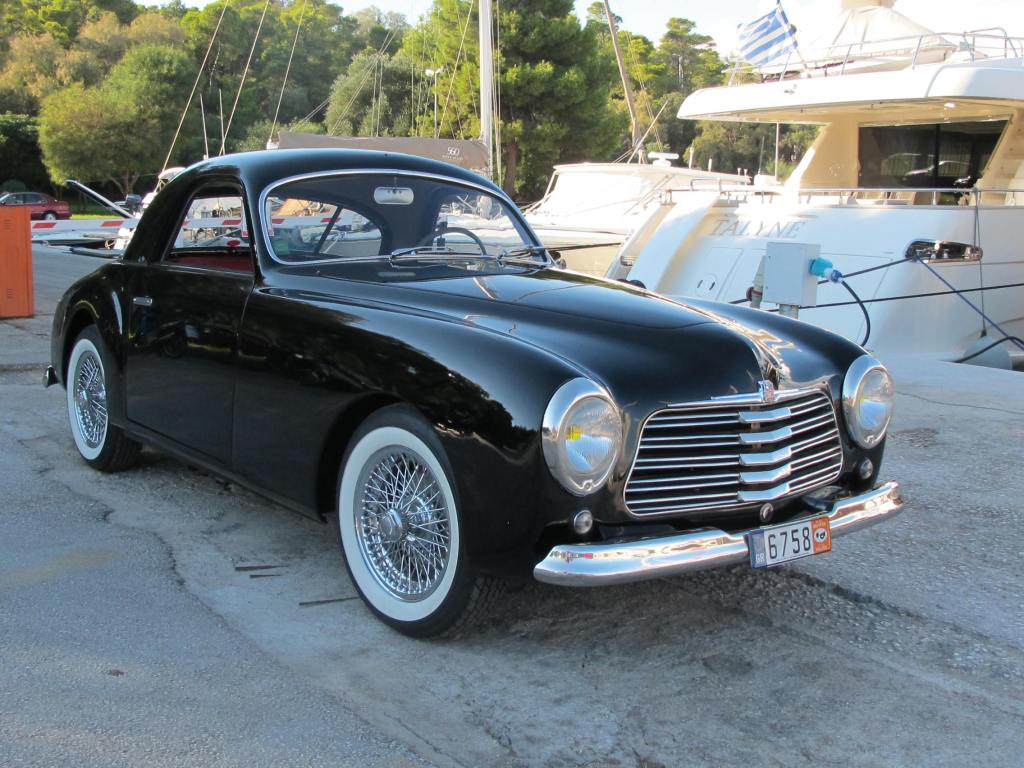
Few close friends cum classic car aficionados, often meet at a very special Garage in Glyfada, a southern suburb of Athens, Greece. Among drinks and pizza slices we discuss matters pertaining to our hobby, review our host Alex V.’s new acquisitions and occasionally negotiate a friendly deal.
It was during such an evening in late September of 2015 that I became interested in the 1950 Simca 8 Sport Coupé, a fully restored example which Alex had imported from Holland few months ago, previously owned and lovingly restored by Gerard et Jeanethe Meckelenkamp. Here is a video documenting that era:
Excitement mounted when few days later I drove down in the GLK to Glyfada accompanied by my friend-mechanic Makis (who undertook the mechanical restoration project of our 1957 Lancia Aurelia GT B20S), to take delivery and assume the new ownership! I saw again the Simca (Société Industrielle de Mécanique et Carrosserie Automobile) but this time from a different perspective. I was wondering if she was an easy starter or not. If she had any mechanical issues which would unexpectedly surface during my inaugural 20 plus kilometers drive from Alex’s home to my Garage. If she was a smoker, if she suffered from excessive brake fade, and other such concerns which accompany a new classic car acquisition of some 65 years of age…

Alex started the little Coupé on the button (a good omen), drove out of the Garage and parked her on the street for further scrutiny. The initiation procedure included an explanation of the switches, handing over of the thick Dossiers and paperwork which accompany this elegantly sculpted classic by Battista Pininfarina along the cues of his famous 1947 Cisitalia 202 with which the Museum of Modern Art in New York were so impressed that in 1951, they named the Cisitalia one of the ten great automotive designs of all time, putting the car on display. ![]() ☝️
☝️![]() Further fascinating fact, the little Simca 8 Sport was coach-built by Facel-Vega. An interesting trivia pertaining to Facel (Forges et Ateliers des Constructions d’Eure-et-Loir) is that its founder Jean Daninos was a Greek-French individual. My drive back to the north of Athens was uneventful aside from a refueling stop on the way.
Further fascinating fact, the little Simca 8 Sport was coach-built by Facel-Vega. An interesting trivia pertaining to Facel (Forges et Ateliers des Constructions d’Eure-et-Loir) is that its founder Jean Daninos was a Greek-French individual. My drive back to the north of Athens was uneventful aside from a refueling stop on the way.

According to many collectors opinion, a significant historic vehicle must encompass these attributes: elegance, important design, sporting performance, rarity, interesting provenance/story line and finally to be nicely presented in as authentic condition as possible. In a nutshell to have Desirability. I do believe that this example of a 1950 Simca 8 Sport Coupé, ticks all the boxes 🙂

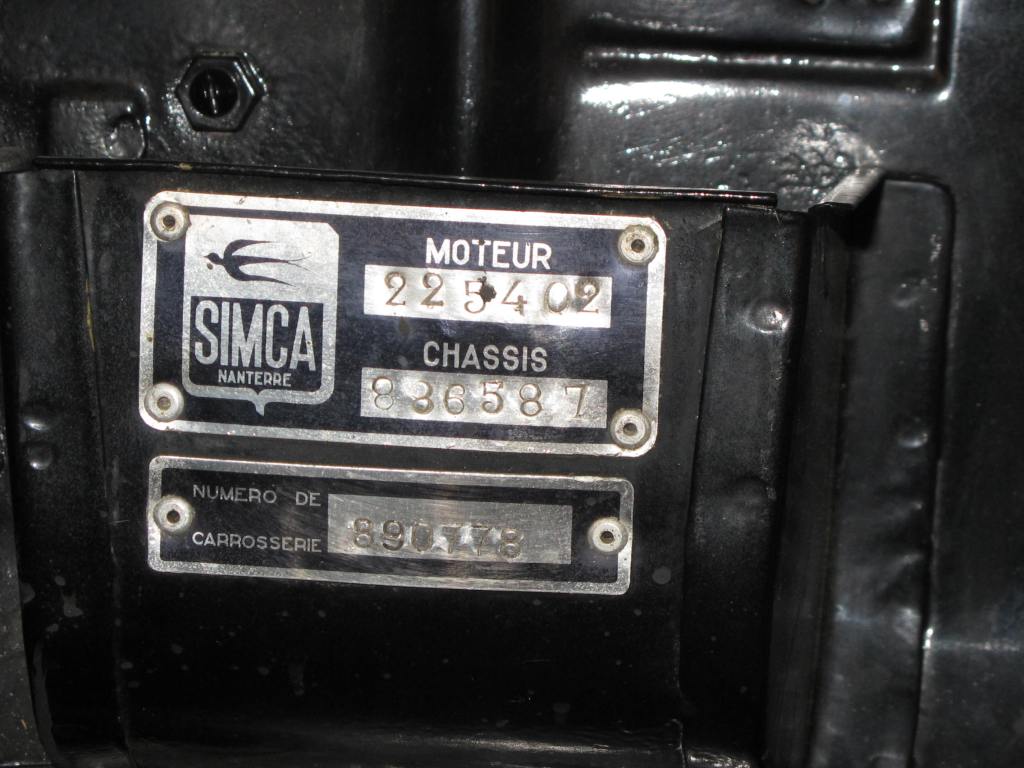

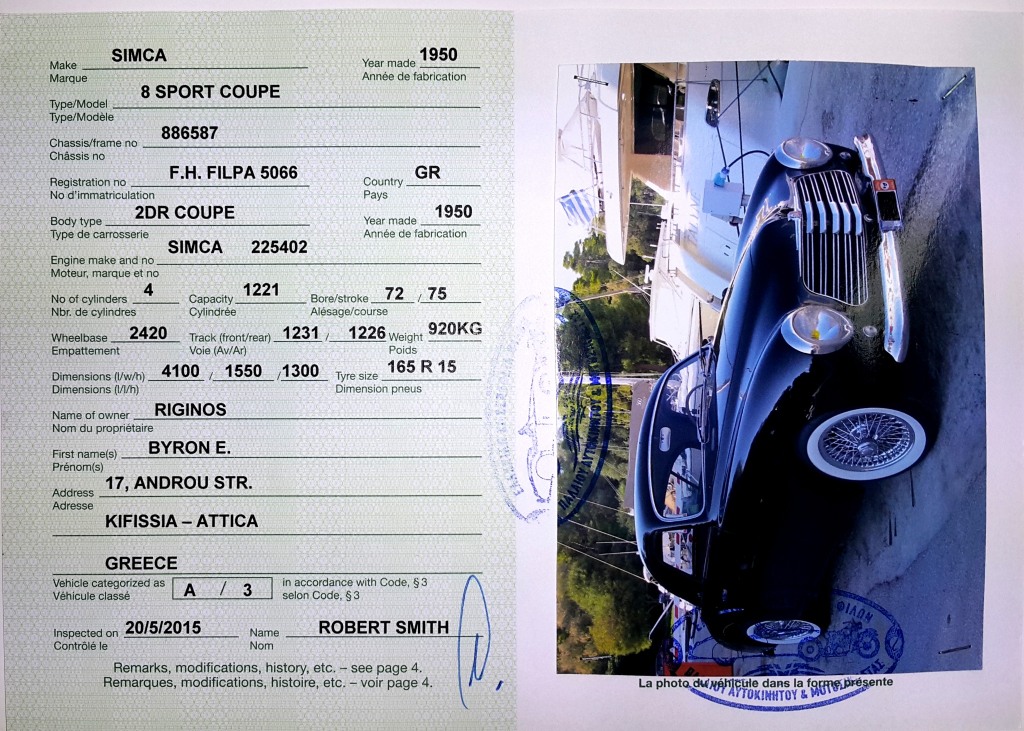
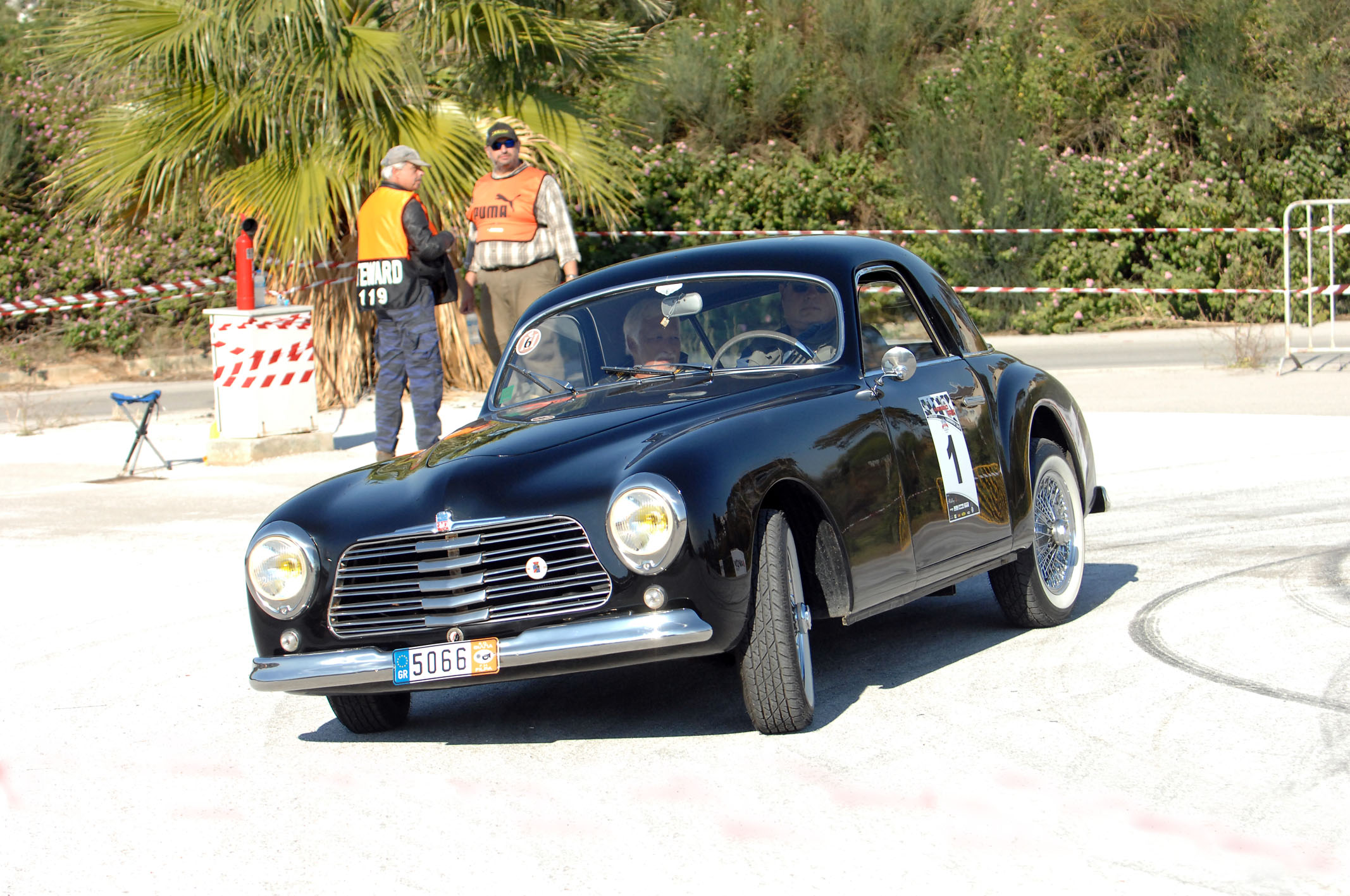
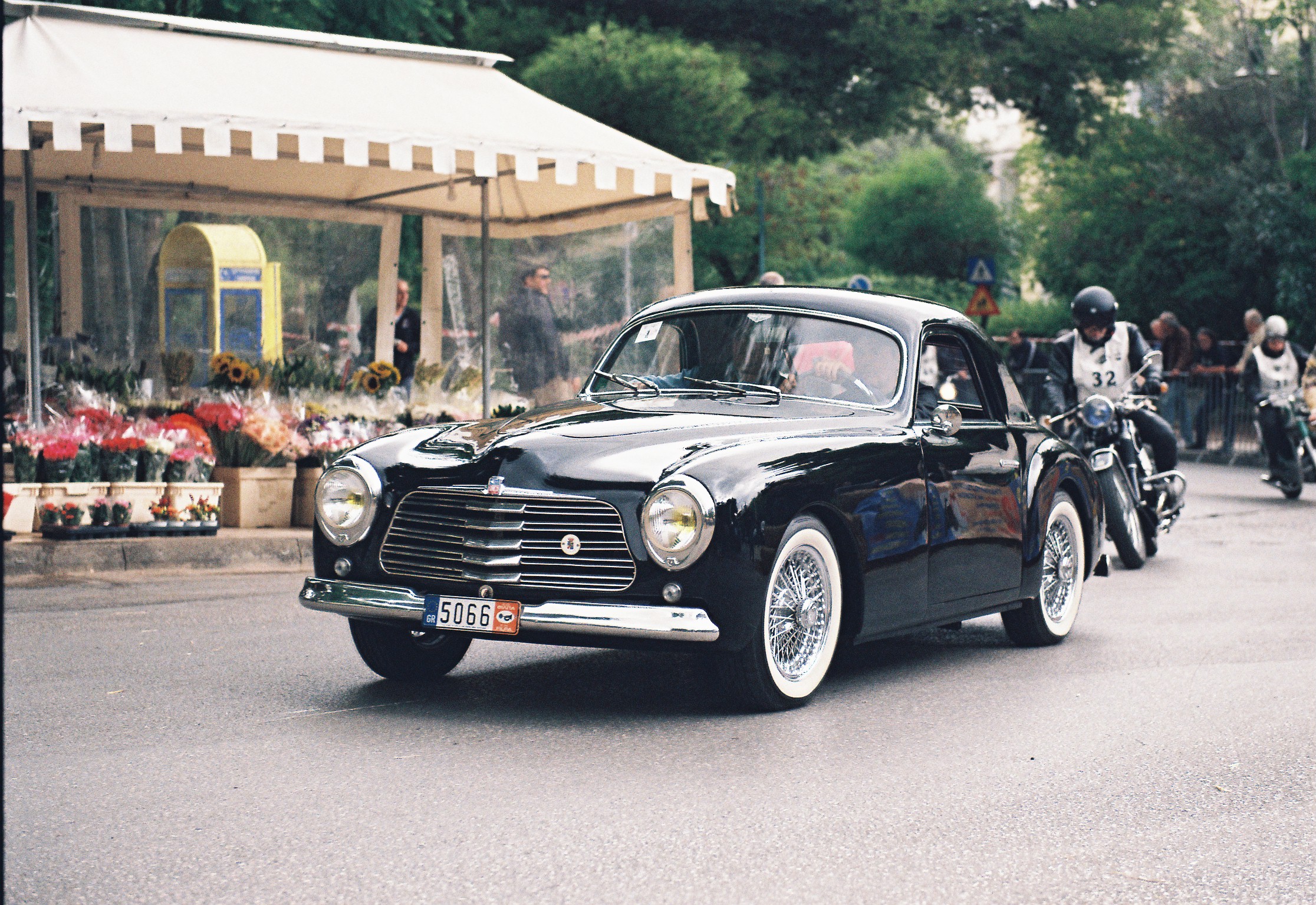
Here is a fun video from that event:
Here is the history of the Simca 8 Sport Coupé:
 First presented at the 1948 Auto Show, was a convertible which created a sensation. Henri Pigozzi wanted to offer its customers a sporty version of the Simca 8, valued for its performance, durability and economy. The convertible has its genesis in the Cisitalia 202 designed by Pinin Farina in 1947 and adapted by Giovanni Michelotti on the chassis of the Fiat 1100 S. In Paris, it charms the audience with the elegance of its bodywork.
First presented at the 1948 Auto Show, was a convertible which created a sensation. Henri Pigozzi wanted to offer its customers a sporty version of the Simca 8, valued for its performance, durability and economy. The convertible has its genesis in the Cisitalia 202 designed by Pinin Farina in 1947 and adapted by Giovanni Michelotti on the chassis of the Fiat 1100 S. In Paris, it charms the audience with the elegance of its bodywork.
The based in France Simca was originally a subsidiary of Fiat, created on 2 November 1934 to build its models under license in France in order to avoid paying import taxes and customs duties. Its founder was, Turin born Enrico Teodoro Pigozzi, who later changed his name to Henry Theodore. In 1926 he was given the task of organizing a sales network for SAFAF (Société Anonyme Française des Automobiles Fiat) that had come into being. The problem with this entity was protectionism which affected every nation, caused by the global economic crisis of 1929. This withdrawal resulted in tariffs increasingly greater that prevented the Fiat cars to be competitive with the French productions.
 In 1935 Simca settles after redemption in the modern Donnet factory in Nanterre. Production starts on July 1st and the very first Simca-Fiat (name to be given in 1938) came out of the chain. Very quickly Simca becomes the fourth French manufacturer and it’s vehicles feature a new crest with a swallow symbolizing the brand’s slogan: a bird’s appetite. This approach allowed to delete the affiliation of the brand to its Italian parent company while xenophobia was growing in France, especially towards the Fascist Italy.
In 1935 Simca settles after redemption in the modern Donnet factory in Nanterre. Production starts on July 1st and the very first Simca-Fiat (name to be given in 1938) came out of the chain. Very quickly Simca becomes the fourth French manufacturer and it’s vehicles feature a new crest with a swallow symbolizing the brand’s slogan: a bird’s appetite. This approach allowed to delete the affiliation of the brand to its Italian parent company while xenophobia was growing in France, especially towards the Fascist Italy.
Presented on the French market in 1938, the Simca 8 is derived from the Fiat 1100 “Nuova Balilla 508C” manufactured in the Simca-Fiat factories of Nanterre under license. As a middle class car, it competes with Peugeot 202 and Renault Juvaquatre. Like Fiat, it has a front face with an egg-shaped grille and round headlights salient and prominent. The body is much more aerodynamic than the old Simca-Fiat/CV SAFAF 6 it replaces. The engine is a 4-cylinder 1.089 cc developing 32 hp at 4200 RPM. Distribution, as on many Fiat engines with overhead valves. Suspensions are independent wheels at the front and the rear solid axle. Drum brakes on all 4 wheels with hydraulic circuit. With a 4-speed box, it reaches 110 km / h.
When the Second World War breaks out, the automobile business in France stops. Well, not quite for Simca. The Germans want all companies involved in the war effort, especially to produce vehicles for the Russian front. Each plant is assigned a director appointed by the occupier. But the Fiat company whose country, Italy, is an ally of Germany was awarded a Simca administrator or a director of Fiat-Germany. In fact, the plant would continue to produce in Nanterre autos for another three years, unlike the Citroën plants, Peugeot and Renault, constrained to produce military hardware for the German Army. In 1943, the setbacks of the German Army lead to the termination of the preferential treatment enjoyed by Simca. The plant was assigned for the maintenance of military vehicles and various fabrications for the occupying Germany, including mechanical elements for NSU Motorenwerke.
After World War II, Paul-Marie Pons was appointed Deputy Director of the Mechanical and Electrical Industries Division (DIME) of the Department of Industrial Production and launches the “Plan Pons” with the objective of streamlining automotive manufacturing. Simca is integrated within the G.F.A. (Générale Française de l’Automobile) with Panhard, Delahaye, Delage, Unic, Laffly and Bernard. The President of the Employers’ Federation of Automobile Manufacturers, Charles Petiet, presents Simca on track thanks to the support of the Minister of Industrial Production then but in exchange following the guidelines of the Plan Pons, the company is committed to make the AFG (French Aluminium Gregory) developed by the engineer Jean-Albert Grégoire, now technical director general of Simca since October 1944.
The particular French car market was then theoretically divided into three main sectors. Citroen, with the Traction Avant, must occupy the high-end, Renault and Peugeot the middle, Panhard and Simca the low end, with the industrialization of the AFG. A first prototype of the Simca Gregory was made in 1945, then a second in 1946. Unfortunately for Grégoire, Henri Pigozzi, who had been quietly following his contacts with the German occupiers, managed to derail this project and resumed the management of the company. Simca escapes the nationalization and constraints of the government, leaving Panhard to fend for itself. For its part, Renault’s 4 CV imposes its Peugeot and maintains its presence on the average niche or middle sector.
Production starts with the Simca 5 and then the 8. While in Italy, Fiat had already replaced this model by Fiat 1100 B, and the Simca 8 gets a restyling with changes of the front bumper, grille, the hood and trunk. It receives on this occasion a larger engine of 1.221 c.c.’s developing 41 BHP.
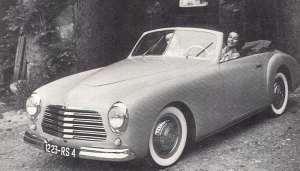
At the 1948 Paris Motor Show it is presented alongside the sedan, plus a convertible that causes a sensation. Henri Pigozzi wanted to offer its customers a sporty version of the Simca 8, which was valued for its performance, durability and economy. The convertible had its genesis in the Cisitalia 202 designed by Pinin Farina in 1947. He built a few copies before delegating production to his elder brother Giovanni, founder of the Stabilimenti Farina, and Vignale as well. The Stabilimenti Farina, founded in 1906 by Giovanni Farina in Turin, had employed the very talented Mario Boano, Giovanni Michelotti and Battista “Pinin” Farina, the latter departing in 1930. Giovanni Michelotti was entrusted with the adaptation of lines of the Cisitalia to the proportions of the frame of the Fiat 1100 S. This car caught the attention of Henry Theodore Pigozzi during a visit to Turin. He immediately ordered a second copy so as to display it at the Paris Salon where the car charmed the audience with the elegance of its bodywork.
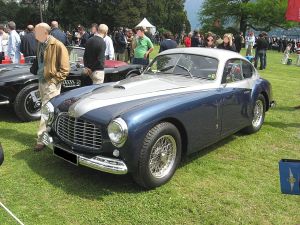
The design of the Cisitalia marked history again when it was picked for the Ferrari 166 Inter, the first convertible model of the Prancing Horse, which would be presented at the 1949 Geneva Motor Show. The warm welcome of the Simca 8 Sport encouraged Henri Theodore Pigozzi to start making the car very quickly. However, the amount of production of Stabilimenti Farina was very limited and to export the convertible, it was necessary to overcome high taxes. Pigozzi also used Jean Daninos, founder Facel Metallon, with which it had good relations, which already had the opportunity to work with Pinin Farina for Bentley coach-building and had appropriate industrial facilities for the establishment of a production line dedicated to the Simca 8 Sport Cabriolet and its Coupe version in the study phase.
The actual production of the Simca 8 Sport began in March 1950, in both Coupé and Cabriolet. The body parts were produced in Amboise, the assembly line was installed in Colombes and the finish was ensured by the factory in Dreux, justifying the high price of the car, twice that of the sedan. More powerful, with 50 against 40 hp for the sedan, the Simca 8 Sport allowed a speed of 135 KPH, a respectable performance for a relatively small displacement engine but disappointing for a car for sporting purposes. But anyway, the customers were more sensitive to its elegance.

Considered the most beautiful French car at the time, the Simca 8 Sport would have a short career as its body was modified in 1951 to accommodate the platform of the new Aronde. The convertible that can accommodate only the cut remains, becomes the Simca 9 Sport with a windshield in one piece to the show in 1952 where it gave way to a new generation with fully drawn Simca model as the Aronde based Simca Sport Plein Ciel. A production run of 5.165 Simca 8 Sport, including all versions was made.
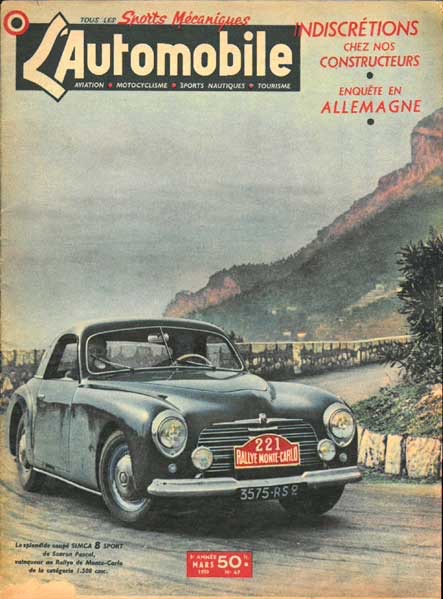
• More interesting readings:
http://www.simcafacel.levillage.org/
http://www.simcafacel.levillage.org/spip.php?article404
http://simcafacel.levillage.org/rubrique.php3?id_rubrique=15
http://bringatrailer.com/2015/03/26/restored-1950-simca-8-sport/?corder=asc#comments
• Photo Album Presentation of the 1950 Simca 8 Sport Coupé
https://www.flickr.com/photos/128623295@N04/albums/72157652566683011/page1
https://www.flickr.com/photos/128623.
https://www.facebook.com/media/set/?set=a.10154102435384897.1073742183.181783909896&type=3
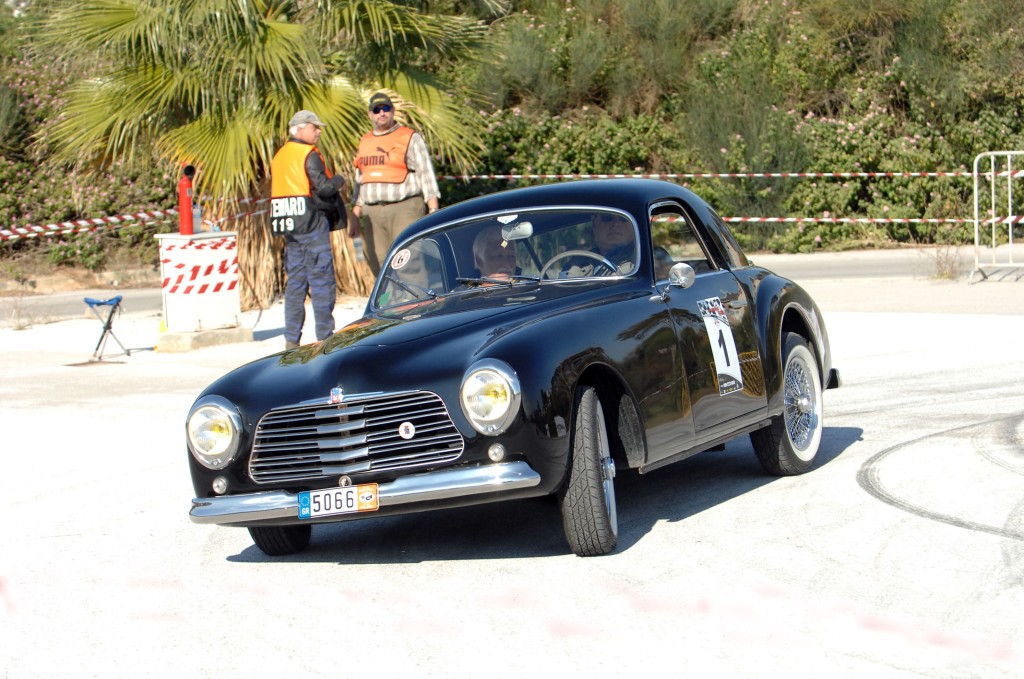
Leave a comment